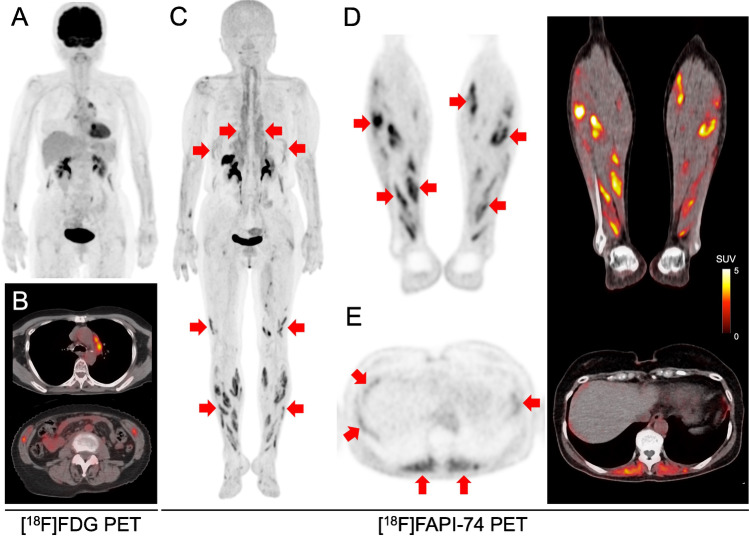A 73-year-old female patient with papillary thyroid cancer underwent 18F-fluorodeoxyglucose ([18F]FDG) and 18F-fibroblast activation protein inhibitor-74 ([18F]FAPI-74) positron emission tomography (PET) for the evaluation of metastatic lesions prior to surgery. She had been diagnosed with sarcoidosis histologically using biopsies from the mediastinal lymph node and skin 7 years before, and CT scan prior to PET scan showed enlargement of the mediastinal lymph nodes. [18F]FDG PET showed increased uptake in the mediastinal lymph nodes, suggestive of reactive uptake, or metastasis (Fig. A and B: maximum intensity projection (MIP) and axial fusion). Additionally, mild uptake was observed in the diaphragm and oblique muscles. However, the lower extremities were not included in the scanned area, as no abnormal accumulation was found in the proximal thigh within the normal imaging range from the top of the head to the mid-thigh. On [18F]FAPI-74 PET, multiple regions of abnormal uptake were observed in the lower extremity muscles (Fig. C and D: MIP and coronal PET and fusion, red arrows). These abnormal uptakes exhibited a linear or bar-shaped pattern along the muscular striations (SUVmax = 7.32). Mild linear accumulation was also observed in the diaphragm, and increased uptake was also detected in the paraspinal muscles (Fig. C and E: MIP and axial PET and fusion, red arrows). The patient has been followed up with the diagnosis of sarcoidosis in the lungs, skin, and eyes. Based on her history and muscle uptake patterns, she was diagnosed with muscular sarcoidosis (asymptomatic sarcoid myopathy).
According to previous studies, the ‘leopard-man sign’ or ‘tiger-man sign’ is observed on 67Ga scintigraphy and [18F]-FDG PET among patients with sarcoid myopathy [1, 2].
Asymptomatic myopathy occurs in 50–80% of patients with sarcoidosis, while less than 5% of patients have clinical symptoms [2]. Marie et al. observed multiple linear uptake patterns on [18F]-FDG in the calf and thigh muscles of both legs in a patient with biopsy-proven pulmonary and muscular sarcoidosis [3]. This was considered the typical pattern for sarcoid myopathy, and its imaging finding is similar to that observed on [18F]FAPI-74 PET of the present case despite the difference of being asymptomatic without any increase in white blood cell count or C-reactive protein. Cardiac sarcoidosis exhibits increased uptake on [68Ga]FAPI-46 PET without increased uptake on [18F]FDG PET. This corresponded to the lesions that exhibited late gadolinium enhancement on magnetic resonance imaging, suggestive of activated fibroblasts in the fibrotic remodelling processes [4]. However, there have been no previous reports on muscle sarcoidosis, presenting with increased uptake on FAPI-PET. To the best of our knowledge, this is the first reported case of activated fibroblasts in sarcoid myopathy. A comparison of MIP images between FAPI-PET and FDG-PET showed high uptake in the paraspinal muscle on FAPI-PET (topmost red arrows in Fig. C), whereas no abnormal accumulation was observed on FDG-PET. We assume that the muscle uptake on FAPI-PET might be due to fibrotic changes by activated fibroblasts in the chronic phase, independent of the active inflammation detectable on FDG-PET since the patient was asymptomatic and had been stable for years without further treatment. The potential limitation of the present case report is the lack of histological confirmation of sarcoid myopathy, as the biopsy was not justified for the asymptomatic patient. Chronic muscular sarcoidosis should be suspected when the typical pattern of multiple muscle uptake is observed on FAPI-PET.
Author contribution
Conceptualization: T.W and F.L.G. Data collection: T.W, T.F, M.T, S.N, T.K, H.K, Y.M, C.J, and F.L.G. Original draft preparation: T.W. Review and editing: F.L.G. Supervision: I.H and F.G. All authors have read and agreed to the submitted version of the manuscript.
Funding
Open access funding provided by Osaka University.
Data availability
Data sharing not applicable to this article as no datasets were generated or analysed during the current study.
Declarations
Consent for publication
Written informed consent was obtained from the patient.
Conflict of interest
FLG is an advisor at ABX Radiopharmaceuticals, SOFIE Biosciences, Telix pharma, and Alpha Fusion. FLG has also shares in a consultancy group for iTheranostics. The other authors declare no potential conflicts of interest relevant to this study.
Footnotes
Publisher's note
Springer Nature remains neutral with regard to jurisdictional claims in published maps and institutional affiliations.
References
- 1.Fayad F, Duet M, Orcel P, Lioté F. Systemic sarcoidosis: the “leopard-man” sign. Joint Bone Spine. 2006;73(1):109–112. doi: 10.1016/j.jbspin.2005.04.007. [DOI] [PubMed] [Google Scholar]
- 2.Wieërs G, Lhommel R, Lecouvet F, Van den Bergh P, Lambert M. A tiger man. Lancet. 2012 24;380(9856):1859. [DOI] [PubMed]
- 3.Marie I, Josse S, Lahaxe L, Levesque H, Hitzler A. Clinical images: muscle sarcoidosis demonstrated on positron emission tomography. Arthritis Rheum. 2009;60(9):2847. doi: 10.1002/art.24796. [DOI] [PubMed] [Google Scholar]
- 4.Siebermair J, Kessler L, Kupusovic J, Rassaf T, Rischpler C. Cardiac fibroblast activation detected by 68Gallium-FAPI-46 positron emission tomography-magnetic resonance imaging as a sign of chronic activity in cardiac sarcoidosis. Eur Heart J Case Rep. 2022 9;6(1):ytac005. [DOI] [PMC free article] [PubMed]
Associated Data
This section collects any data citations, data availability statements, or supplementary materials included in this article.
Data Availability Statement
Data sharing not applicable to this article as no datasets were generated or analysed during the current study.



